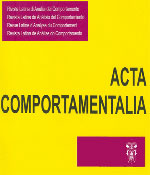The emergence of sentence reading as stemming from teaching their constituent parts
Main Article Content
Abstract
Is teaching just words sufficient to ensure reading more complex texts? Wouldn’t it be also necessary to have a basic repertoire of sentence reading? Taking these questions as a starting point, it has been chosen as an aim to teach students to read and write words, to identify numerals and color names, and in test circumstances to read “sentences” made out of such elements. After teaching words, numerals, and color names separately, these elements have been grouped in order to make sentences which, in test circumstances, have been presented to the participants to read. At this stage, called grouping, no experimental consequence has been presented to the participant. By means of this procedure, one aimed to check if teaching classes of stimuli separately would generate, once grouped, the emergence of a broader repertoire, namely sentence reading. Seventeen first grade children of both sexes, aged from six and seven years, took part in that research. Such students belonged to a public, state school, situated in a city in south Brazil. The participants have been selected for the experimental group based on the scores obtained by means of the application of a preliminary test that evaluated the relations AB, AC, AE, CE, CD, BC, and CB of words, numerals, and color names; the students who presented the lowest scores of correct answers have been chosen. The other participants of the preliminary test took part in the control group; they have been evaluated also in an intermediary test and in a final test of reading. At the inter–test periods, only children in the experimental group took part in the teaching procedure. The research took place at the school library, on a reading desk. Two notebooks have been used, along with multimedia devices, and the educational software Mestre@. The classes of responses of reading and writing nouns as well as the classes of identifications of numerals and color names have been taught by means of a procedure of conditional discrimination through the exclusion of already known stimuli. Model and comparison stimuli as well as experimental contingencies have been presented also through the computer programs. In the reading test words, numerals and color names have all been jointly tested, forming sentences, whose performance didn’t result in any consequences. One grouping equivalence test has been performed to check if reading was being done meaningfully. Out of 11 children, six have read the presented sentences with 100 percent of accuracy. One child has read with 100 percent of accuracy the first and second sets, and two children have read the first set with 100% accuracy, too. Two children dropped out about halfway the research. This research showed that it is possible, after teaching isolated words, to provoke the emergence of sentence reading with comprehension.
Article Details
How to Cite
Gonçalves Medeiros, J., Antunes, L., Pokreviescki, J. E. J., Bottenberg, D. G., de Amorim Ferreira, C., & Eickhoff Cavalhieri, K. (2011). The emergence of sentence reading as stemming from teaching their constituent parts. Acta Comportamentalia, 19(3). Retrieved from https://journals.unam.mx/index.php/acom/article/view/28047
Citas en Dimensions Service

<a rel="license" href="http://creativecommons.org/licenses/by-nc-sa/4.0/"><img alt="Licencia de Creative Commons" style="border-width:0" src="https://i.creativecommons.org/l/by-nc-sa/4.0/88x31.png" /></a><br />Este obra está bajo una <a rel="license" href="http://creativecommons.org/licenses/by-nc-sa/4.0/">licencia de Creative Commons Reconocimiento-NoComercial-CompartirIgual 4.0 Internacional</a>.
